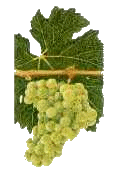
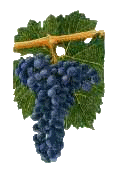
 Wine grapes have an ancient history, but they have only been growing in California for a couple of hundred years. Father Junipero Serra was the first to introduce wine grapes to California when he planted vines, brought from Mexico, at the San Diego Mission shortly after its founding in 1769. A few years later the first winery in Alta California was built at the San Gabriel Mission, and it remained the largest of the mission wineries for many years. Mission fathers brought wine grapes with them north to Napa Valley at the founding of the Sonoma Mission in 1823, and up until that time the missions were the only wine-grape growers in California.
Wine grapes have an ancient history, but they have only been growing in California for a couple of hundred years. Father Junipero Serra was the first to introduce wine grapes to California when he planted vines, brought from Mexico, at the San Diego Mission shortly after its founding in 1769. A few years later the first winery in Alta California was built at the San Gabriel Mission, and it remained the largest of the mission wineries for many years. Mission fathers brought wine grapes with them north to Napa Valley at the founding of the Sonoma Mission in 1823, and up until that time the missions were the only wine-grape growers in California.
Called the Mission variety, the wine grape of the padres is the same as the Criolla grape that was brought to Mexico by the conquistadors, and it is thought to be descended from the Monica grape of Sardinia. Ancient vines, the largest in California and probably the oldest as well, still exist at mission San Gabriel. However, these vines are not descendents of the padres grapes, as is sometimes told to tourists, but were planted by Dr. David Halland in 1861.
The American Joseph Chapman planted a commercial vineyard of Mission grapes in Los Angeles in 1824, as did California pioneer William Wolfskill at his Los Angeles vineyard a few years later. William and his brother John also planted Mission grapes at their Putah Creek ranch in Yolo and Solano counties, perhaps as early as 1843, and became in 1849 the first winemakers in California to ship wine to San Francisco.
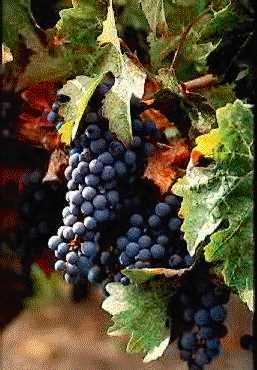 Jean Louis Vignes, a Frenchman from Bordeaux, imported French vines to Los Angeles in the 1830s, enabling him to produce wine far superior to that of the padres' Mission grapes. As Vignes' wines gained reknown, others also began experimenting with European grape varieties and initiated a tremendous expansion of the California wine industry. Much of this growth is credited to the Hungarian Count Agoston Haraszthy de Mokcsa, who introduced many of the 125 varieties of Vitis vinifera grapes found in California today, including the probable importation of the "so-called" California variety Zinfandel from his homeland.
Jean Louis Vignes, a Frenchman from Bordeaux, imported French vines to Los Angeles in the 1830s, enabling him to produce wine far superior to that of the padres' Mission grapes. As Vignes' wines gained reknown, others also began experimenting with European grape varieties and initiated a tremendous expansion of the California wine industry. Much of this growth is credited to the Hungarian Count Agoston Haraszthy de Mokcsa, who introduced many of the 125 varieties of Vitis vinifera grapes found in California today, including the probable importation of the "so-called" California variety Zinfandel from his homeland.
Wine grapes were first planted in Green and Suisun valleys in the 1850s, during the California Gold Rush, when a handful of prospectors, returning empty handed from the gold fields, forsook the miners life, turned to farming, and planted grapevines to complement their other crops. They followed the lead of the pioneer Wolfskill brothers, who had come west not for gold but land and furs, and planted vines on the valley slopes while saving the bottom lands along the creeks for field crops.
Green Valley quickly gained reknown as a premier wine district. One of the first to make wine in the valley was an Austrian named John Volypka who settled his ranch in 1858, planted vines, and built a wine cellar. By 1863, his operation was known as the Belle Vista Winery, and he was shipping wines to San Francisco by train from a newly built train station at nearby the Cordelia Junction.
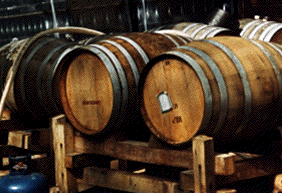 Another Green Valley grower was Fred (F.S.) Jones, who arrived in 1860 or 1868 and became the largest wine producer, and later the largest cherry producer as well, in the area. The Jones winery reportedly had a cellar that held 50,000 gallons of wine. Others who started large wineries in Green Valley in the 1860s included Henry Shultz of the C. Shultz & Co. Winery and Henry Brown. The impressive remains of one of these wineries can still be seen today on the west side of Berryessa Highway just north of the old Rockville Cemetary.
Another Green Valley grower was Fred (F.S.) Jones, who arrived in 1860 or 1868 and became the largest wine producer, and later the largest cherry producer as well, in the area. The Jones winery reportedly had a cellar that held 50,000 gallons of wine. Others who started large wineries in Green Valley in the 1860s included Henry Shultz of the C. Shultz & Co. Winery and Henry Brown. The impressive remains of one of these wineries can still be seen today on the west side of Berryessa Highway just north of the old Rockville Cemetary.
Infestations of the phylloxera plant louse began devastating European vineyards in the 1860s and cut the French wine industry to a fourth its former splendor in just a few years. The louse soon spread to California and devastated Green Valley and Napa Valley vineyards alike in the 1870s. Although wine grapes were still grown, many growers, among them the Jones family, could not recover vineyards they had lost and turned to fruit orchards, in particular cherries, and other crops. Though still rampant today, phylloxera is now dealt with by grafting cuttings of the more desirable Vitis vinifera grapes onto hardy, louse-resistant root stock derived from Vitis rupestris and other wild grape species of the Eastern United States.
The havoc wrought by the phylloxera epidemics was small compared to the blow dealt by the 1919 enactment of Prohibition. Wineries across the state closed, and unable to market their grapes, growers tore up their vineyards and turned to other livelyhoods.
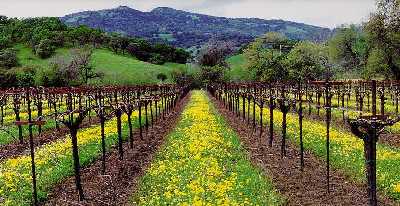 When winemaking returned to Solano County in 1832 with the opening of Wooden Valley Winery, Suisun Valley emerged as the new center of the local wine industry. More vineyards and wineries sprang up with the prosperity that followed the end of World War II, and more came with the "wine boom" that started in 1967. Old vineyards were revived, new ones planted, and once more local wines made from local grapes, which just a few years before were sent over the hill to make generic wines in Napa Valley.
When winemaking returned to Solano County in 1832 with the opening of Wooden Valley Winery, Suisun Valley emerged as the new center of the local wine industry. More vineyards and wineries sprang up with the prosperity that followed the end of World War II, and more came with the "wine boom" that started in 1967. Old vineyards were revived, new ones planted, and once more local wines made from local grapes, which just a few years before were sent over the hill to make generic wines in Napa Valley.
Demand for Suisun Valley grapes and wines continues to grow, and both Suisun Valley and Green Valley now support a multitude of vineyards, such as Bella Vista Ranch, in addition to several fine wineries. The small size of these operations allow the winemakers to handcraft their wines and work closely with local growers to determine the grapes best suited to the local geography, climate and soil - the same spirit of innovation and independence that distinguished the Green Valley winemakers and growers of the 1860s.
